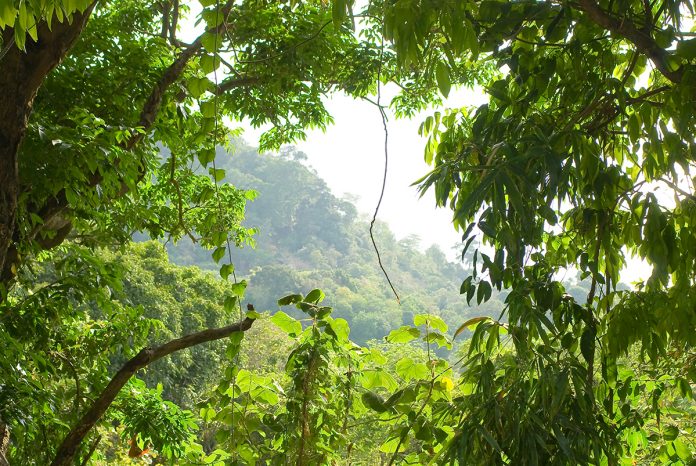Professor Jess K. Zimmerman from the University of Puerto Rico, explains how natural disturbances, such as hurricanes, can affect the Luquillo Experimental Forest (LEF)
The Luquillo LTER project has pioneered a balanced approach in which the self-organising mechanisms of ecosystems are disrupted by periodic disturbances (e.g., hurricanes, landslides), on the one hand, and constrained by legacies and large-scale, slow-tempo environmental change (i.e., land use and global climate change) on the other.
How do hurricanes affect forests of the LEF?
In 1989, Hurricane Hugo devastated the LEF with wind speeds of 148 km h-1 and rainfall of 225 mm d-1. The forest canopy was heavily affected, and while the initial mortality of trees was relatively low at 7-9%, studies of delayed mortality showed that 30% of broken and 55% of uprooted stems died within 5 years after the storm.
As devastating as the effects of Hurricane Hugo were, forest resilience was surprising. In a few months, the understory became alive with herbs and shrubs and newly recruited tree saplings. Some forest processes such as soil nutrient cycling and stream chemistry returned to near pre-hurricane levels quickly, exhibiting a high degree of resilience. Forest structure, stream-water exports of coarse particulate matter, and abundances of some plants and animals recovered slowly or never fully recovered their pre-Hugo values. However, resilience overall was high.
Nine years later, another intense hurricane, Georges, provided the opportunity to compare the effects of different storms on forest structure and resilience. Hurricane Georges resulted in much less structural and compositional change, largely because the branch structure of the forest had not fully recovered from Hugo, reducing the effects of the second storm on the forest canopy and the amount of generated woody debris.
Two hurricanes (Irma and María) struck the LEF in close succession 2017. Hurricane Irma (September 7) passed to the north and had mild to moderate effects on the site. Hurricane María (September 20), with strong, category 4 winds (248 km h-1 at landfall), passed near the LEF and caused widespread defoliation and significant alteration of forest and stream structure. Hurricane María was the strongest hurricane to make landfall in Puerto Rico since hurricane San Felipe in 1928. Hurricane María killed twice as many trees as Hurricane Hugo, and for all but two species, broke 2- to 12-fold more stems than Hurricanes Hugo or Georges. Because of Maria’s strength, stem breakage was not related to tree species wood density, as was found for Hugo and Maria. Thus, even species with strong trunks are vulnerable to intense storms, which may influence the overall resilience of the forest to these kinds of events.
How does disturbance affect biodiversity in the LEF?
Studies of the effects of hurricanes on biodiversity in the LEF suggest that plant and animal populations are quite resilient to disturbance. Although the immediate effect of hurricanes is quite variable among different species, over time abundance of organisms seems to be quite stable. Moreover, overall species richness is not affected much by hurricanes. Changes in plant community composition after a hurricane tends to return to pre-hurricane conditions after about 60 years, in the absence of further disturbance. Because hurricanes have always been a part of the environment of the LEF, natural selection has eliminated those species that are unable to cope with a variable environment.
Studies of hurricanes Hugo and Georges have shown that cyclonic storms alter physical and chemical characteristics of ecosystems but have relatively fewer effects on biological characteristics (e.g., species richness).
How will climate change affect forests of the LEF?
Our studies suggest that tropical ecosystems of the LEF are highly resilient to many disturbances, both anthropogenic and non-anthropogenic in nature (Brokaw et al., 2012). We anticipate three principal changes wrought by a warming world. Warming itself may challenge species’ physiological tolerances and alter species demography. Increased warming may also increase the frequency of intense hurricanes driven by the warmed waters of the North Atlantic and increase the frequency or length of dry periods, coupled with a change in the seasonality of rainfall. These last two changes suggest a world in which precipitation extremes become more common as extended dry periods are combined with more numerous heavy rainfall events.
More fundamentally, we ask whether the range of conditions contemplated under the global change scenario for the Caribbean exceeds the historical range relevant to evolutionary time spans. Forests of the LEF have been subject to hurricane disturbance since at least the Last Glacial Maximum (Zimmerman et al. 2020). There is evidence that the frequency of intense tropical cyclone landfalls (between 250 and 1150 C.E) have exceeded current frequencies across the Caribbean over the last 2000 years. Similarly, periods of drying in the last 10,000 years may have created extinction filters favouring drought-tolerant species.
Studies from the Pacific hurricane belt suggest that frequent cyclones result in forests with reduced stature but with demographic and trait dynamics similar to Caribbean forests that suffer little exposure to cyclonic storms. These results suggest future changes to LEF forests may result from selection for increases in the abundances of species most resistant to the changing climate or disturbance regime, without a distinct change in ecosystem function. Although the composition of the forest may change, the change may occur more gradually. We will be watching to see. In any case, the deep history of changing climate and disturbance regimes in the LEF likely explains the robust resilience to a disturbance in the LEF that we have witnessed in the last century of research.
References
Brokaw, N.V.L., Crowl, A.T., Lugo, A.E., McDowell, W.H., Scatena, F.N., Waide, R.B., and Willig, M.R., 2012. A Caribbean Forest Tapestry: The Multidimensional Nature of Disturbance and
Response. Oxford University Press, New York.
Reagan, D.P., and R.B. Waide, (Eds.) 1996. The Food Web of a
Tropical Rain Forest. Univ Chi. Press, Chicago, Illinois.
Zimmerman, J.K., Willig, M.R., Hernández-Delgado, E., 2020.
Resistance, resilience, and vulnerability of social-ecological systems to hurricanes in Puerto Rico. Ecosphere, in press.
*Please note: this is a commercial profile











